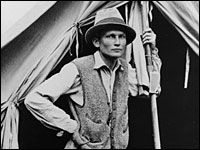The Possessed
By ARTHUR LUBOW
NYT Magazine
June 24, 2007
The stones at Machu Picchu seem almost alive. They may be alive, if you credit the religious beliefs of the ruler Pachacuti Yupanqui, whose subjects in the early 15th century constructed the granite Inca complex, high above a curling river and nestled among jagged green peaks. To honor the spirits that take form as mountains, the Inca stoneworkers carved rock outcrops to replicate their shapes. Doorways and windows of sublimely precise masonry frame exquisite views. But this extraordinary marriage of setting and architecture only partly explains the fame of Machu Picchu today. Just as important is the romantic history, both of the people who built it in this remote place and of the explorer who brought it to the attention of the world. The Inca succumbed to Spanish conquest in the 16th century; and the explorer Hiram Bingham III, whose long life lasted almost as many years as the Inca empire, died in 1956. Like the stones of Machu Picchu, however, the voices of the Inca ruler and the American explorer continue to resonate…
(more…)
Elections could avert Peru’s lawsuit
Source: Yale Daily News by Andrew Mangino, Staff Reporter
April 12, 2006
As this week’s heated Peruvian presidential election enters a runoff, the
government of Peru has not yet filed a lawsuit against Yale for the return of
precious Machu Picchu artifacts excavated in the 1910s, casting doubt on the
future of the dispute.
Nearly a century has passed since Yale historian Hiram Bingham III’s
discovery of the artifacts that redefined universal understanding of the Incan
culture, but archeological experts say the historical record is murky, citing
contracts that seem to confirm Peru’s right to ask for Bingham’s findings to be
returned on the one hand and Yale’s longstanding custodianship of the artifacts
on the other hand. Whether or not Peru will follow through with its promise
to sue Yale may hinge on the incoming government’s attitudes toward national
identity, regional experts said, though there are still a number of complicated
legal, ethical and historical questions that must still be answered by both
parties…
(more…)

Peru dispute has long, murky past: Fate of Incan artifacts found by Hiram Bingham in 1911 may be decided in court
Source: Yale Daily News by Andrew Mangino, Staff Reporter
April 14, 2006
Hike a mere half-mile up Hillhouse Avenue, take a right on Sachem Street, and
a mysterious world 3,500 miles away suddenly emerges: the ancient Inca
society at Machu Picchu, Peru.
Unassumingly sandwiched between plain classroom buildings, the Yale
Peabody Museum, home to the exhibit, features an epic photo of rolling canyons and
ancient clay homes. An Inca Aryballos for holding corn beer sits in a glass
case. Three Sapa Incans are dressed in colorful robes. An eerie whisperer utters
over the PA system in Quechua, the native Incan language.
On the dark wall, a photograph of Yale historian Hiram Bingham III, who
excavated the artifacts and many more from the region in 1911, is pictured as
part of the original expedition that, the poster reads, included topographers,
medical doctors, a geologist, an osteologist, an archeological engineer and
even several Yale students.
But one central part of the story is conveniently missing from the
exhibit: a 95-year-old tale of discovery and deceit, world-class research and
nationalist movements, politics and pride, ambiguity and conviction. It is the
illustrious tale of the ever-changing relationship between Yale and Peru, a
partnership that hit its lowest point yet last month when the Peruvian government
reiterated its demand for the artifacts to be returned and declared its intention
to sue the University in the coming months…
(more…)

